Liftoff to Separation
SpaceShipOne, with its landing gear retracted, was rolled on a dolly underneath White Knight and then raised using a hand crank. The top of SpaceShipOne attached to a two-point pylon that was mounted on the belly of White Knight. Two hooks inside the pylon, fore and aft, clamped onto SpaceShipOne, securing the vehicles together, as shown in figure 3.3. Heating ducts from White Knight to SpaceShipOne also ran through the pylon. The wings of SpaceShipOne were further secured by braces running down from White Knight. The clearance between the two was only a meager 1 foot.
The optimum time to launch from Mojave Airport was at daybreak. Figure 3.4 shows a predawn preflight briefing, which reviewed the mission readiness and addressed any last-minute concerns. After White Knight, carrying SpaceShipOne, rolled out of the Scaled
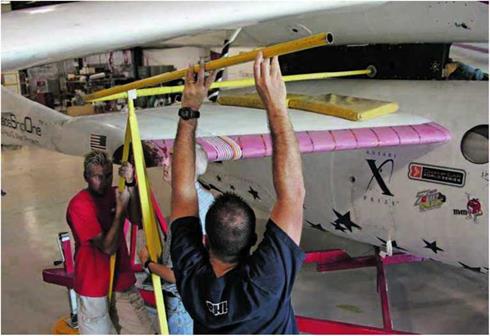 r ; л
r ; л
Fig. 3.3. SpaceShipOne attached to White Knight at several points. A pylon underneath White Knight housed two hooks that fit into two rings on top of SpaceShipOne. A brace between each set of wings also helped to stabilize SpaceShipOne and keep it from swaying back and forth. Mojave Aerospace Ventures LLC, photograph by David M. Moore
V__________________ J
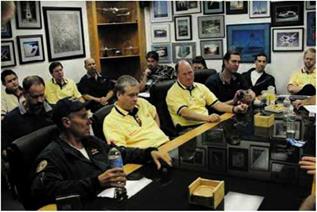 |

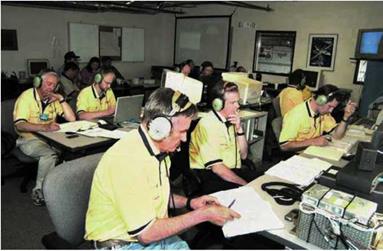
г ^
Fig. 3.4. Early in the morning before each test flight, a preflight briefing was held so that the test pilots, ground crew, and Mission Control could review the details of the flight plan and receive updates on the status of the vehicles and the weather conditions. Mojave Aerospace Ventures LLC, photograph by Scaled Composites
V___________________________________________
( ; t
Fig. 3.5. White Knight and SpaceShipOne taxi to Mojave Airport’s Runway 30. Located less than eighty miles northeast of Los Angeles, Mojave Airport became the first inland spaceport and the first public spaceport licensed by the FAA. Mojave Aerospace Ventures LLC, photograph by Scaled Composites
V__________________ )
( ; >
Fig. 3.6. Inside Mission Control, the flight director, Doug Shane (seated
front row center), was the point person on the ground who communicated directly to the pilots aboard SpaceShipOne and White Knight during all phases of the mission. The Mission Control staff monitored all aspects of SpaceShipOne based on the instrument and video data transmitted by the craft. Mojave Aerospace Ventures LLC, photograph by Scaled Composites
v___________________________________________ J
Composites hangar and final preparations were completed, the two vehicles taxied out to the runway. Figure 3.5 shows White Knight and SpaceShipOne getting ready for takeoff. Once in the air, White Knight headed 40 miles (64 kilometers) to a release box, an area that had been designated by the FAA.
Early in the program, the target for the separation altitude was
50.0 feet (15,240 meters). However, both the characteristics of the air, more specifically the density, and the performance of White Knight, or lack thereof, favored a separation altitude closer to
47.0 feet (14,330 meters). For this first stage of the ascent, White Knight spiraled up at a rate of about 700 feet per minute (210 meters per minute). And by the time the vehicles reached 45,000 feet (13,720 meters), the vehicles were above about 85 percent of the atmosphere.
“We fly up there on White Knight, and that is a really long period of time. It is close to an hour to get up there,” Melvill said.
“I really hated the ride up there,” he continued. “No one wants to talk to you. They think you need to sit there and concentrate on what you are about to do. I really would have liked someone to distract me and have a conversation about something else, because an hour is a long time to sit there and worry about what’s going to happen.
“You start getting close to the drop zone and close to the altitude. Then you go through a pretty extensive checklist setting the airplane up. You trim it 10 degrees nose up, so that when it drops off, it holds its nose up.”
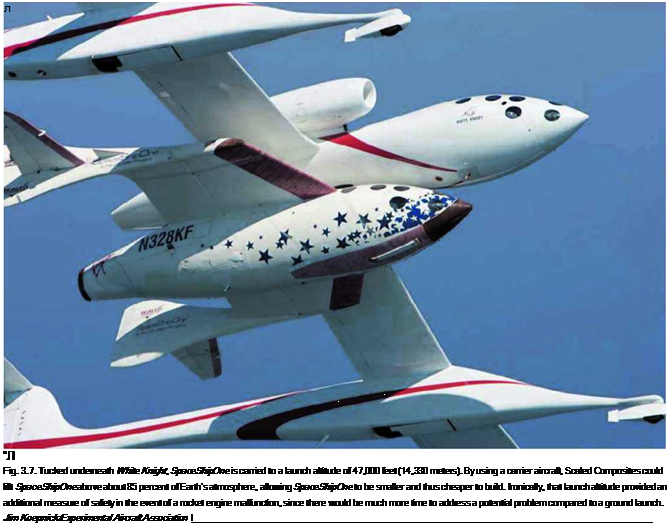
Watching for the slightest abnormality, Mission Control carefully monitored the flight data and video transmitted by SpaceShipOne during the entire flight, as figure 3.6 shows.
It was possible to rotate the entire horizontal stabilizer on each of the tail booms. Adjusting it with 10 degrees nose-up trim would help ensure that SpaceShipOne didn’t go into a dive once it detached from White Knight. This setting was also necessary to help force the nose up once the rocket engine fired, enabling SpaceShipOne to move from horizontal flight to nearly vertical flight.
Figure 3.7 shows a close-up of SpaceShipOne during the captive-carry.
The procedure for the airborne launch of the rocket-powered second stage from the carrier aircraft was pretty simple. Even before the 1920s, flying vehicles had been dropped by larger flying vehicles. And NASA extensively used motherships for dropping X-planes and even for flight testing the Space Shuttle (refer to figure 3.8 and figure 3.9, respectively).
White Knight had to remain steady with its wings level. The pilot in SpaceShipOne began the sequence by arming part of his release system. In the cockpit of White Knight, a yellow light then came on. White Knight would arm next, giving another yellow light. At that point, the release handle inside White Knight became “hot.” A crew member in the backseat pulled it to retract the hooks. White Knight shook with a big bang as the spring-loaded hooks came to a sudden stop. SpaceShipOne dropped away as White Knight surged upward.
“There is an instant feel of you climbing,” said Pete Siebold about flying White Knight during this separation. “You lost almost half your weight. You were at 1 g and it jumped up to 1.6 g’s the second you pulled the release handle.”
Siebold flew SpaceShipOne three times, but all the test pilots pulled double duty when it came to flying. During flight tests with SpaceShipOne, one of the other SpaceShipOne pilots always flew White Knight.
г л
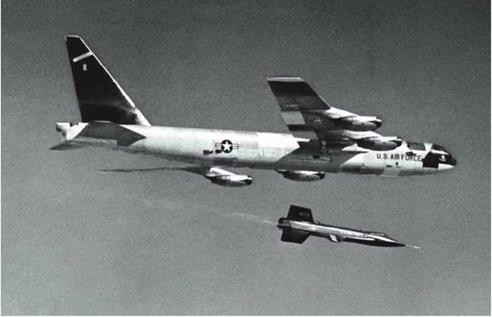
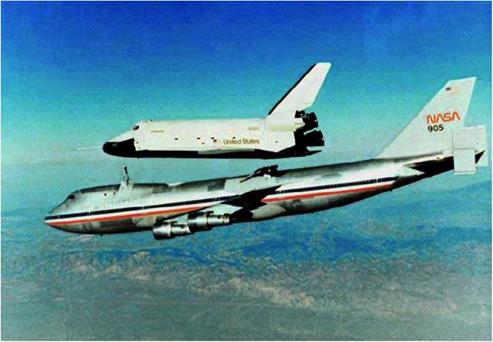 Fig. 3.8. Carried to a height of
Fig. 3.8. Carried to a height of
45,0 feet (13,720 meters) by a NASA B-52, the North American X-15 dropped from the wing at a speed of 500 miles per hour (800 kilometers per hour). The X-15 would typically carry out one of two missions: high-speed hypersonic (faster than Mach 5) test flights or high-altitude test flights. NASA-Dryden Flight Research Center
V J
Г Л
Fig. 3.9. The Space Shuttle Enterprise launches from the top of a NASA 747 Shuttle Carrier Aircraft (SCA). During the test flight, Enterprise glided back down to Dryden Flight Research Center, so aerodynamic and control characteristics could be evaluated prior to an actual spaceflight. NASA-Dryden Flight Research Center
For safe separation from White Knight, as shown in figure 3.10, the pilot in SpaceShipOne pushed forward on the control stick. This briefly counteracted the trim setting on the horizontal stabilizer. So, instead of wanting to pitch up, SpaceShipOne dipped down to avoid re-contacting White Knight.
Gliding for about 10 seconds, SpaceShipOne grew quiet, since it was now out of earshot of White Knight’s engines. The pilot made some quick final checks with Mission Control.
“You have to get the motor started as soon as you possibly can because you are just teetering on the edge of a stall,” Melvill added. “You’ve got all
that rubber fuel at the back of the airplane.” The center of gravity for SpaceShipOne was very far back. If its nose pointed up too high, without the rocket engine going, a stall would develop that would cause the spaceship to lose aerodynamic control. A pilot could recover from this, but SpaceShipOne would have lost a good deal of altitude in the process.










